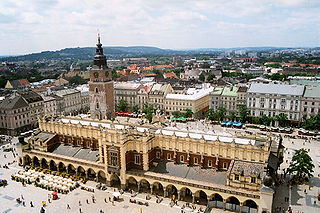Kraków Cloth Hall
 Kraków Cloth Hall | |
| Construction | |
|---|---|
| Period | Renaissance in Poland |
| Status | Central feature of UNESCO World Heritage Site |
The
History
It was once a major centre of international trade. Travelling merchants met there to discuss business and to barter. During its golden age in the 15th century, the hall was the source of a variety of exotic imports from the east – spices, silk, leather and wax – while Kraków itself exported textiles, lead, and salt from the Wieliczka Salt Mine.
In the immediate vicinity of the hall, the
 Gallery, with stalls | |
 Sukiennice by night |
Kraków was Poland's capital city and was among the largest cities in
The hall has hosted many distinguished guests over the centuries and is still used to entertain monarchs and dignitaries, such as
Upper-floor museum

On the upper floor of the hall is the
The Gallery of 19th-Century Polish Art was a major cultural venue from the moment it opened on October 7, 1879. It features late Baroque, Rococo, and Classicist 18th-century portraits and battle scenes by Polish and foreign pre-Romantics; the art of partitioned Poland with famed Prussian Homage by Jan Matejko; mythological and biblical scenes with the monumental Nero's Torches by Henryk Siemiradzki, the art of representative members of Young Poland from the turn of the 20th century including Jacek Malczewski, Józef Chełmoński; prominent impressionists Józef Pankiewicz and Leon Wyczółkowski; paintings by Wojciech Gerson and Julian Fałat, as well as large, and controversial Ecstasy, or Frenzy of Exultations by Władysław Podkowiński among other masterpieces.[3]
Historical images
-
Before 19th-century restoration
-
Kraków Cloth Hall in 1915
-
Kraków Cloth Hall in 1930
See also
- Culture of Kraków
- Events in Kraków
References
- ^ Aleksandra Krypczyk (2009). "History of the Gallery in the Sukiennice". About the Museum. National Museum in Krakow. Archived from the original on November 1, 2012. Retrieved November 21, 2012.
- ^ Aleksandra Krypczyk (2009). "Galeria Sztuki Polskiej XIX wieku w Sukiennicach (Gallery of Polish Art in Sukiennice)". About the museum (in Polish and English). National Museum in Krakow. Archived from the original on October 21, 2013. Retrieved November 26, 2012.
- ^ National Museum in Krakow (2009). "Sala Chełmońskiego: Realism, Polish Impressionism and Symbolism". Gallery of Polish 19th century art in the Sukiennice (in Polish). Official website. Archived from the original on September 6, 2012. Retrieved November 29, 2012.




